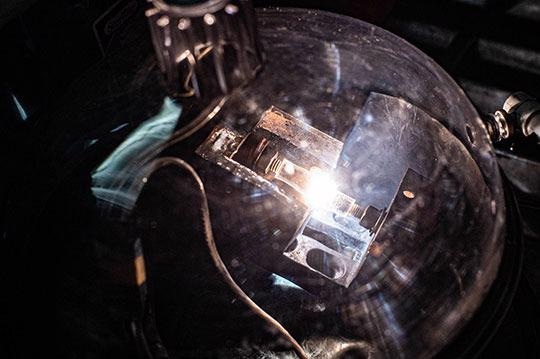“Flashing” graphene into reality from waste was a good start. But now, scientists at Rice University are tailoring it.
 Rice University chemists have modified their flash Joule heating process to produce doped graphene with tailored properties for optical and electronic devices. The flash graphene method can turn any source of carbon into valuable 2D materials in milliseconds. Image Credit: Jeff Fitlow/Rice University.
Rice University chemists have modified their flash Joule heating process to produce doped graphene with tailored properties for optical and electronic devices. The flash graphene method can turn any source of carbon into valuable 2D materials in milliseconds. Image Credit: Jeff Fitlow/Rice University.
The Rice University lab of chemist James Tour has altered its flash Joule heating procedure to create doped graphene that customizes the atom-thick material’s electronic states and structures to make them more appropriate for electronic and optical nanodevices. The doping method incorporates other elements into the 2D carbon matrix of graphene.
The procedure described in the American Chemical Society journal ACS Nano demonstrates the way graphene can be doped using a single element or with trios or pairs of elements. The procedure was shown with single elements of phosphorus, boron, oxygen, nitrogen and sulfur, a two-element mixture of nitrogen and boron, and a three-element mix of nitrogen, boron and sulfur.
The procedure takes around 1 second and is completely reliant on “flashing” a powder that integrates the dopant elements with carbon black. Furthermore, it is catalyst-free and solvent-free.
Doping graphene is viable using bottom-up methods such as chemical vapor deposition or artificial organic processes, but these typically produce products in trace quantities or create flaws in the graphene. The Rice method is a favorable path to yield large amounts of “heteroatom-doped” graphene rapidly and without catalysts, solvents or water.
This opens up a new realm of possibilities for flash graphene. Once we learned to make the original product, we knew the ability to directly synthesize doped turbostratic graphene would lead to many more options for useful products.
James Tour, Chemist, Rice University
“These new atoms added to the graphene matrix will permit stronger composites to be made since the new atoms will bind better to the host material, such as concrete, asphalt, or plastic. The added atoms will also modify the electronic properties, making them better-suited for specific electronic and optical devices,” James Tour added.
Graphene is turbostratic when piles of the 2D honeycomb-like lattices do not orient with one another. This renders it easier to scatter the nanoscale sheets in a solution, creating soluble graphene that is a lot simpler to add to other materials, Tour explained.
The lab experimented with numerous doped graphenes in two situations: electrochemical oxygen reduction reactions (ORR) that are important to catalytic systems such as fuel cells, and as part of an electrode in lithium metal batteries that denote the next generation of rechargeable batteries possessing high energy densities.
Sulfur-doped graphene was demonstrated to be ideal for ORR, while nitrogen-doped graphene was demonstrated to be able to decrease nucleation overpotential all through the electrodeposition of metallic lithium. That should enable more even deposition and better stability in advanced rechargeable metal batteries, the lab stated.
Rice University graduate students Weiyin Chen and Chang Ge are co-lead authors of the article. Co-authors are alumnus John Tianci Li, graduate students Jacob Beckham, Paul Advincula, Kevin Wyss, Jinhang Chen, Lucas Eddy, undergraduate Robert Carter, postdoctoral researcher Zhe Yuan, research scientist Carter Kittrell, and alumnus Duy Xuan Luong.
The study received support from the Department of Energy-National Energy Technology Laboratory (DE-FE0031794), the Air Force Office of Scientific Research (FA9550-19-1-0296), and the U.S. Army Corps of Engineers’ Engineer Research and Development Center (W912HZ-21-2-0050).
Journal Reference:
Chen, W., et al. (2022) Heteroatom-Doped Flash Graphene. ACS Nano. doi.org/10.1021/acsnano.2c01136.